
Slough is a town in the unitary authority of the same name in Berkshire, England, bordering Greater London. It lies in the Thames Valley, 20 miles (32 km) west of central London and 19 miles (31 km) north-east of Reading, at the intersection of the M4, M40 and M25 motorways. It is part of the historic county of Buckinghamshire. In 2020, the built-up area subdivision had an estimated population of 164,793. In 2011, the district had a population of 140,713.

Berkshire is a historic county in South East England. One of the home counties, Berkshire was recognised by Queen Elizabeth II as the Royal County of Berkshire in 1957 because of the presence of Windsor Castle, and letters patent were issued in 1974. Berkshire is a county of historic origin, a ceremonial county and a non-metropolitan county without a county council. The county town is Reading.
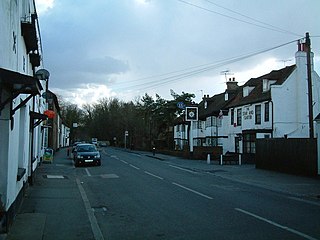
Colnbrook is a village in the Slough district in Berkshire, England. It lies within the historic boundaries of Buckinghamshire, and straddles two distributaries of the Colne, the Colne Brook and Wraysbury River. These two streams have their confluence just to the southeast of the village. Colnbrook is centred 3 miles (4.8 km) southeast of Slough town centre, 3.5 miles (5.6 km) east of Windsor, and 19 miles (31 km) west of central London.

Wraysbury is a village and civil parish in the Royal Borough of Windsor and Maidenhead in England. It is under the western approach path of London Heathrow airport. It is located on the east bank of the River Thames, roughly midway between Windsor and Staines-upon-Thames, and 18 miles (29 km) west by south-west of London. Historically part of Buckinghamshire, Wraysbury was made part of the new non-metropolitan county of Berkshire in 1974, under the Local Government Act 1972. The Wraysbury Reservoir is located to the east, administratively wholly in the Spelthorne district of Surrey, although it was historically divided between Buckinghamshire and Middlesex.
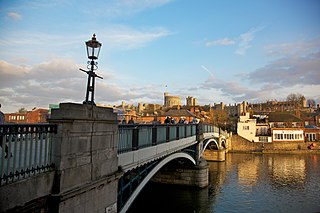
Windsor is a historic market town and unparished area in the Royal Borough of Windsor and Maidenhead in Berkshire, England. It is the site of Windsor Castle, one of the official residences of the British monarch. The town is situated 21.8 miles (35.1 km) west of Charing Cross, central London, 5.8 miles (9.3 km) southeast of Maidenhead, and 15.8 miles (25.4 km) east of the county town of Reading. It is immediately south of the River Thames, which forms its boundary with its smaller, ancient twin town of Eton. The village of Old Windsor, just over 2 miles (3 km) to the south, predates what is now called Windsor by around 300 years; in the past Windsor was formally referred to as New Windsor to distinguish the two.
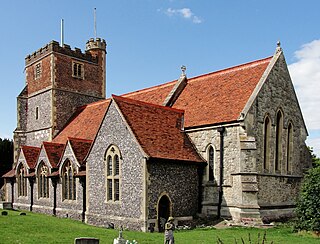
Horton is a village and civil parish in Berkshire, England. It is between Windsor and Staines-upon-Thames.

Prince Christian of Schleswig-Holstein was a minor Danish-born German prince who became a member of the British royal family through his marriage to Princess Helena of the United Kingdom, the fifth child and third daughter of Queen Victoria and Prince Albert of Saxe-Coburg-Gotha.
Magna Carta Island is an ait in the River Thames in England, on the reach above Bell Weir Lock. It is in Berkshire facing water-meadows forming Runnymede. Its civil and ecclesiastical parish is Wraysbury so it was transferred from Buckinghamshire to Berkshire in 1974.
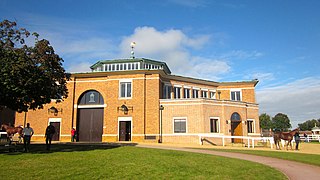
Tattersalls is the main auctioneer of race horses in the United Kingdom and Ireland.

Windsor Great Park is a Royal Park of 2,020 hectares, including a deer park, to the south of the town of Windsor on the border of Berkshire and Surrey in England. It is adjacent to the private 265 hectares Home Park, which is nearer the castle. The park was, for many centuries, the private hunting ground of Windsor Castle and dates primarily from the mid-13th century. Historically the park covered an area many times the current size known as Windsor Forest, Windsor Royal Park or its current name. The park is managed and funded by the Crown Estate, and is the only royal park not managed by The Royal Parks. Most parts of the park are open to the public, free of charge, from dawn to dusk, although there is a charge to enter Savill Garden.
Timothy Wonnacott is an English chartered auctioneer, chartered surveyor, antiques expert, narrator, and a television presenter. He was previously a director of Sotheby's, one of the world's oldest auction houses.

Choonilal Devkaran Nanjee (1890–1948), also known as C. D. Desai, was a twentieth-century Indian commodity trader, financier, and philatelist.

Arthur Gostick Shorrock (1861–1945) was a Baptist missionary who worked in China for 40 years. Arthur was born in 1861 in Blackburn, Lancashire, England. He entered Spurgeon's College and as a student preacher took services at the Baptist Chapel in Wraysbury. There he met his future wife, Maud Doulton, a relative of both Henry Doulton the pottery manufacturer and William Thomas Buckland the Wraysbury auctioneer. Arthur then left to become a missionary in China before returning to live in Wraysbury after his retirement.
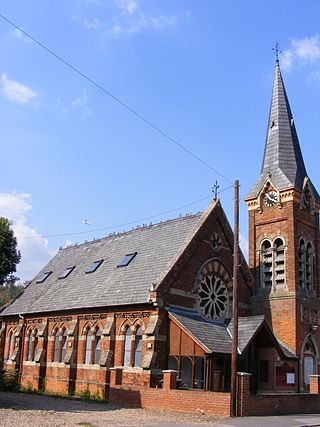
Wraysbury Baptist Chapel is in the village of Wraysbury, Berkshire, England. The present day building was opened in 1862, but the chapel was first established in 1827.
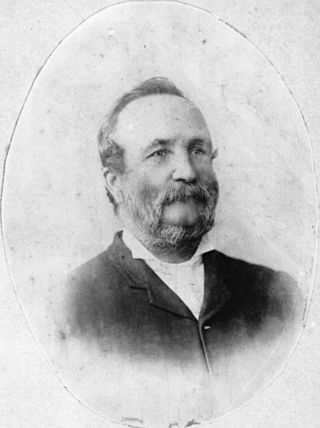
John Francis Buckland (1825–1910) was an auctioneer and a Member of the Legislative Assembly of Queensland.

St George's Chapel at Windsor Castle in England is a castle chapel built in the late-medieval Perpendicular Gothic style. It is both a Royal Peculiar and the Chapel of the Order of the Garter. St George's Chapel was founded in the 14th century by King Edward III and extensively enlarged in the late 15th century. It is located in the Lower Ward of the castle. The castle has belonged to the monarchy for almost 1,000 years and was a principal residence of Elizabeth II before her death. The chapel has been the scene of many royal services, weddings and burials – in the 19th century, St George's Chapel and the nearby Frogmore Gardens superseded Westminster Abbey as the chosen burial place for the British royal family. The running of the chapel is the responsibility of the dean and Canons of Windsor who make up the College of Saint George. They are assisted by a clerk, verger and other staff. The Society of the Friends of St George's and Descendants of the Knights of the Garter, a registered charity, was established in 1931 to assist the college in maintaining the chapel.
Alfred Savill (1829–1905) was the founder of Savills, one of the United Kingdom's largest estate agents.
King Sturge was an international property consultancy with over 210 offices and 4,200 staff in 45 countries. They operated throughout the UK and Europe and had associations and partners in Asia Pacific and North, Central and South America. The firm covered all property sectors and related services such as logistics, plant and machinery.

The Royal Chapel of All Saints or Queen Victoria's Chapel is a Grade II listed church in the grounds of the Royal Lodge in Windsor Great Park, Berkshire, England and is a Royal Peculiar, serving as an informal parish church for the inhabitants and staff of the Windsor Great Park. Services at the chapel are often attended by members of the British royal family, and Queen Elizabeth II regularly worshipped at the church for reasons of privacy. The chaplaincy of the Royal Chapel All Saints is held by one of the Canons of the College of St George at St George's Chapel, Windsor Castle.
Major-General William Driscoll Gosset FRSE (1822–1899), also Gossett, was a British Army officer serving in the Royal Engineers. A skilled engineer and surveyor, he did much work on the original British Ordnance Survey.
















